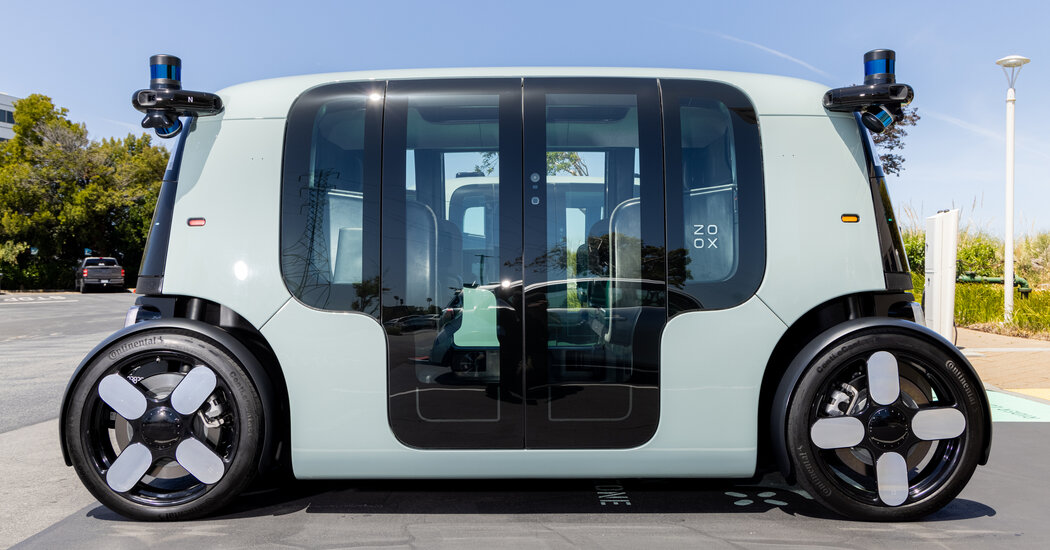Two research labs known for some of the tech industry’s most important innovations have merged in hopes of recapturing their glory days.
It is one of Silicon Valley’s enduring legends.
In 1979, a 24-year old Steve Jobs was permitted to visit Xerox’s Palo Alto Research Center (PARC) to view a demonstration of an experimental personal computer called the Alto. Mr. Jobs took away a handful of ideas that would transform the computing world when they became the heart of Apple’s Lisa and Macintosh computers.
Four decades later, PARC has become a footnote in the nation’s technology heartland, even as Silicon Valley’s influence has ballooned. Last April, Xerox quietly donated the lab to SRI International, an independent research laboratory that is a nonprofit organization with an equally storied history that has also fallen from its peak of influence. (The organization shortened its name this year to SRI. It used to be the Stanford Research Institute and was separated from the university in 1970. It changed its name to SRI International in 1977.)
PARC’s inventions defined the personal computing revolution, from laser printing to ethernet.
Xerox opens the Palo Alto Research Center as an R&D division on the edge of Stanford’s campus. The mandate of the laboratory is to create “the office of the future.”
Among the first innovations to come out of PARC is a complete system for laser printing, pictured here in a prototype printer model, the Xerox Dover.
PARC creates the Xerox Alto, the first modern personal computer. The Alto features the first graphical user interface, making it possible to control the system by pointing and clicking on menus rather than typing cumbersome commands.
A key part of PARC office of the future vision is a network to tie office systems together. The Ethernet standard is developed at PARC and gradually wins wide industry adoption.
In January, SRI began to disclose its plans for PARC, describing a combined nonprofit research organization, called the Future Concepts division, intent on reclaiming some of the original wizardry that was created when the Xerox Corporation set out to build a basic research laboratory to invent the “office of the future” in 1970.
The PARC laboratory, set in the foothills just south of Stanford, is now largely empty, hosting less than 100 researchers, far from a peak of almost 400. For those who remember its glory days, however, it is a reminder of the research done by a diverse group of scientists and engineers who crossed disciplines and collaborated in a spirit similar to other powerful corporate research centers of that era, such as AT&T’s Bell Laboratories and IBM’s Thomas J. Watson Research Center.
“It’s still magical,” said Eric Schmidt, Google’s former chief executive and executive chairman, who began his career at PARC as a computer scientist and a member of the research team. He remembers, “an amazing cafeteria, the most incredible view from the roof deck of the Bay Area and very large labs on the ground floor that they once used for physics and semiconductor work.”
Today, however, in an era of tightening corporate budgets and more targeted government spending, basic research largely happens at universities. Silicon Valley has adopted a venture capital-based research funding model focused on quickly bringing products to market — often failing just as promptly.
For reasons that range from the more competitive world of computing research to the fact that the communities that surround the laboratory are now among the most expensive places to live in the world, there are many skeptics about the idea of a rejuvenated PARC. And in a technology region now dominated by venture-funded start-ups, some argue that basic research labs like PARC and SRI are passé.
“PARC is dead,” said Bernardo Huberman, a physicist who was a PARC researcher during the 1970s and 1980s and who now heads a research group at CableLabs, a development organization sponsored by the cable television industry. He added that “the value system that made people feel like they were part of something intellectually by working at PARC has disappeared.”
“Now the culture is more mercenary and focused on money rather than knowledge for its own sake,” Mr. Huberman said.
PARC and SRI share a complicated history. During Silicon Valley’s formative years in the 1960s and ’70s, SRI, which is in neighboring Menlo Park, and PARC invented defining concepts that even today continue to shape the computer industry, including advanced chip design, personal computing, laser printing, office networking and what is described as the Internet of Things.
Some of PARC’s computing innovations have their roots in prior research work done in the SRI lab of Douglas Engelbart, the computer scientist who invented the computer mouse and hypertext, the forerunner to the World Wide Web.
Across its 78-year history, SRI’s inventions have evolved from early computer-based check processing systems to the initial version of Siri.
Bank of America contracts with SRI to design a computer-based system to automate the processing of checks. By 1966, the Electronic Recording Machine, Accounting can process 750 million checks a year.
A robot called Shakey moves about its environment. A variety of innovations will come from it, including advances in computer vision, voice recognition and an algorithm that would become the basis for modern navigation and mapping programs.
The computer scientist Douglas Engelbart does a live demonstration of the “oN-Line system” his team at SRI has been developing, showcasing the computer mouse and hypertext – later to become the foundational concept underlying the World Wide Web.
Two young programmers, Bill Duvall at SRI in Menlo Park and Charley Kline at UCLA in Los Angeles, test remotely connecting to a computer via a Pentagon-funded experimental computer network known as ARPAnet.
Siri, which will eventually be turned into a commercial product by Apple, begins as part of a Pentagon-funded SRI artificial intelligence research effort known as CALO, which stands for Cognitive Assistant That Learns and Organizes.
David Parekh, SRI’s chief executive, said that although PARC could not compete directly for talent because of the high salaries now routinely offered by tech giants, it would still be possible to attract scientists and engineers interested in the research freedom that the laboratory would provide. The new, combined lab will have about 1,000 researchers.
Mr. Parekh, who is a mechanical engineer whose background is in the aerospace industry and who became SRI’s chief executive in 2021, said PARC would be able to attract both early-career researchers as well as mid-career and senior researchers.
He acknowledged that while the reinvented PARC would not have a single “invent the office of the future” style-vision of the original laboratory, it would attempt to make advances in a variety of fields ranging from material science inventions to offset the effects of climate change to quantum computing.
PARC is credited with the original graphical computing breakthrough known as the WIMP interface, an acronym for Windows, Icons, Menus, Pointer, that describes a style of human-computer interaction that was popularized by Macintosh and Windows personal computers.
Mr. Parekh said that the stage was now set for a second leap forward in the way humans interacted with computers. That was foreshadowed in basic research done at SRI in the 2000s that led to the commercial spinoff of SIRI, a speech assistant that Mr. Jobs placed at the heart of the iPhone just before his death in 2011.
Mr. Parekh said he believed that the new research center could make major contributions in research on more trustworthy and explainable artificial intelligence systems. SRI has been a pioneer in A.I. research since the 1960s, and Mr. Parekh said that combining today’s neural net technologies with the traditional symbolic A.I. work would pave the way for powerful systems that have the ability to reason.
The Defense Advanced Research Projects Agency, he said, is now funding PARC’s research on futuristic human-machine collaboration, intended to make it possible for people and machines to plan and work together on tasks in both digital and physical worlds.
The challenge, said Curtis Carlson, a physicist who was SRI’s chief executive from 1998 to 2014, will be to create a culture that is able to make the connection between invention and innovation, which he described as invention delivered into the marketplace with a viable business model.
PARC’s inventiveness has always been a source of contention. Xerox was accused of “fumbling the future,” by not effectively commercializing the technology it invented to become a major player in the computer industry. Mr. Jobs took away the technology that still defines Apple’s products, and Charles Simonyi, a young PARC software designer who left to work for Microsoft, took the ideas that would become the heart of both Office and Windows.
Xerox executives had always responded that though they did not successfully compete in the computer market, they got a huge return on their investment by commercializing the laser printer technology PARC invented.
But many researchers who were at PARC’s halcyon early days said that its strength was that their research was unconstrained by the need to create a specific product — a notion that seems hard to imagine in today’s product-oriented Silicon Valley.
In the 1970s, PARC was originally thought of as “hippie-ville,” said Jan Vandenbrande, a former Defense Advanced Research Projects Agency project manager who is now head of research at PARC. That culture, he said, has changed and evolved since then, but has retained a spirit of “how do you make a difference in the world?” and “how do you democratize certain technologies?”
Johan De Kleer, a scientist who spent almost four decades at PARC before leaving recently to found an A.I. software company, said that PARC could be revived only if Mr. Parekh could find a way to build some “slack” into the system by finding money to support open-ended research projects.
SRI may have found that slack. The research laboratory is located in Menlo Park, Calif., in walking distance to the San Francisco to San Jose commuter rail line on 63 of Silicon Valley’s most valuable acres.
Mr. Parekh is now planning to build a modern research campus and residential community with new SRI buildings and space to attract other high-tech companies. The developer will share revenue from the project with SRI.
“This is our annuity for the future for investing in research,” Mr. Parekh said.







